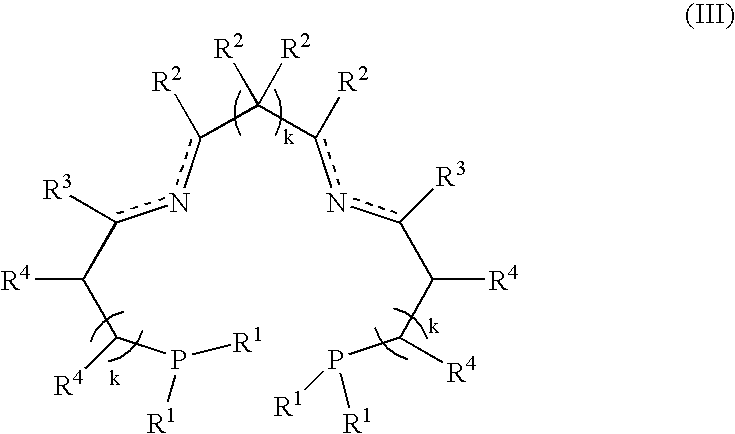Process for hydrogenation of carbonyl and iminocarbonyl compounds using ruthenium catalysts comprising tetradentate diimino-diphosphine ligands
a technology of tetradentate diimino-diphosphine and catalyst, which is applied in the direction of organic compound/hydride/coordination complex catalyst, physical/chemical process catalyst, ruthenium organic compound, etc., can solve the problems of ru/p/sub>2 complex, more difficult to achieve, and disadvantages of using ru/p/sub>(nh)/sub>2 complex
- Summary
- Abstract
- Description
- Claims
- Application Information
AI Technical Summary
Benefits of technology
Problems solved by technology
Method used
Image
Examples
example 1
General Procedure for the Catalytic Hydrogenation of Ketones and Aldehydes With the Complexes [Ru(P2N2)Y2] or [Ru(P2(NH)2)Y2]
A typical experiment was as follows:
A 0.002 M solution of the complex [RuCl2((R,R)-cyP2(NH)2)] was prepared by dissolving 9.9 mg (0.01 mmol) of the complex in 5 ml of CH2Cl2.
A 0.18 M solution of iPrOK was prepared by dissolving 202 mg (1.8 mmol) tBuOK in 10 ml iPrOH.
The glass insert of an autoclave was charged with 7.2 ml iPrOH and 10 μl of the 0.18 M solution of iPrOK (1.8×10−3 mmol). Then, to this mixture were added 2.4 g of acetophenone(20 mmol) and 10 μl of the 0.002 M complex solution (2×10−5 mmol), resulting thus in a reaction mixture having a complex / base / substrate ratio of 1:90:106 (1 ppm of complex).
The charged insert was placed inside the autoclave, which was sealed and pressurized with 45 bar of H2, and its contents magnetically stirred and heated to 60° C.
Samples for analysis by GC were withdrawn after taking the autoclave out of the heating bath a...
example 2
Comparison Between the Performances of the [Ru(P2N2)Y2] Complexes and Their [Ru(P2(NH)2)Y2] Analogues
a) By using a general procedure similar to that described in example 1), the [Ru((R,R)-cyP2N2)Cl2] complexes and its [Ru((R,R)-cyP2(NH)2)Cl2] analogue have been tested under the same conditions for the hydrogenation of acetophenone. Reactants, quantities and results are listed in Table 3.
TABLE 3Comparison of the performances, for the hydrogenationof acetophenone, of [Ru(P2N2)Y2] andtheir [Ru(P2(NH)2)Y2] analoguesTestComplexCom / baseYield / time(e.e.)1[Ru((R,R)-cyP2N2)Cl2] 10 / 900 100 / 3 h18 (R)2[Ru((R,R)-cyP2(NH)2)Cl2]1) 10 / 900 3 / 3 h20 (R)100 / 24 h3[Ru((R,R)-cyP2N2)Cl2] 10 / 45000 100 / 3 h18 (R)4[Ru((R,R)-cyP2(NH)2)Cl2] 10 / 45000 100 / 3 h20 (R)5[Ru((R,R)-cyP2N2)Cl2]100 / 45000 100 / 3 h23 (R)6[Ru((R,R)-cyP2(NH)2)Cl2]100 / 45000 95 / 3 h17 (R)7[Ru((R,R)-cyP2N2)Cl2]100 / 450000100 / 1.5 h 18 (R)8[Ru((R,R)-cyP2(NH)2)Cl2]100 / 450000 86 / 3 h18 (R)Com / base: complex / base molar ratio in ppm relative to the substrat...
PUM
| Property | Measurement | Unit |
|---|---|---|
| Ph | aaaaa | aaaaa |
| volumes | aaaaa | aaaaa |
Abstract
Description
Claims
Application Information
 Login to View More
Login to View More - R&D
- Intellectual Property
- Life Sciences
- Materials
- Tech Scout
- Unparalleled Data Quality
- Higher Quality Content
- 60% Fewer Hallucinations
Browse by: Latest US Patents, China's latest patents, Technical Efficacy Thesaurus, Application Domain, Technology Topic, Popular Technical Reports.
© 2025 PatSnap. All rights reserved.Legal|Privacy policy|Modern Slavery Act Transparency Statement|Sitemap|About US| Contact US: help@patsnap.com



